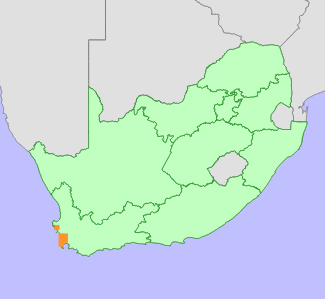|
Scientific Name | Senecio foeniculoides Harv. |
Higher Classification | Dicotyledons |
Family | ASTERACEAE |
Common Names | Fennel-Leaved Groundesl (e) |
National Status |
Status and Criteria | Critically Endangered B2ab(iii,v) |
Assessment Date | 2013/01/24 |
Assessor(s) | D. Raimondo, N.A. Helme & L. von Staden |
Justification | A extremely rare and poorly known species, currently known from a single subpopulation of 150 mature individuals, but possibly still remaining at two other isolated locations. EOO 757 km², AOO estimated <5 km², this species continues to decline due to ongoing habitat loss and degradation. |
Distribution |
Endemism | South African endemic |
Provincial distribution | Western Cape |
Range | Langebaan, Mamre and the Cape Peninsula. |
Habitat and Ecology |
Major system | Terrestrial |
Major habitats | Peninsula Sandstone Fynbos, Hangklip Sand Fynbos, Cape Flats Sand Fynbos, Atlantis Sand Fynbos, Hopefield Sand Fynbos |
Description | Sandy flats and lower slopes. |
Threats |
| Threatened by habitat loss to urban expansion on the Cape Flats and Peninsula, and competition from dense infestations of alien invasive plants around Mamre. The only confirmed extant subpopulation occurs within the West Coast National Park, but is situated within a powerline servitude, which is regularly cleared and brushcut. |
Population |
An extremely rare and seldom recorded species. Previously only known from Mamre and the Cape Peninsula, this species' known range was recently extended as far north as Langebaan, with another isolated subpopulation of about 150 plants recorded in the West Coast National Park in 2012. Prior to this, the species was last recorded in 1997 from near Glencairn on the Cape Peninsula, and from an unspecified locality near Mamre in 1995. In spite of recent and ongoing surveys of lowland fynbos remnants around Mamre for threatened species, this species has not yet been recorded in this area again. A handful of older records date from the 1930s and earlier, and most were collected on the Cape Flats between Rondebosch and Muizenberg, where all subpopulations are now likely to be extinct due to urban expansion, as this species has not been found on well-surveyed remnants such as Kenilworth Racecourse and Rondebosch Common.
|
Population trend | Decreasing |
Assessment History |
Taxon assessed |
Status and Criteria |
Citation/Red List version | | Senecio foeniculoides Harv. | EN B1ab(iii) | Raimondo et al. (2009) | | Senecio foeniculoides Harv. | Lower Risk - Near Threatened | Victor (2002) | | Senecio foeniculoides Harv. | Indeterminate | Hilton-Taylor (1996) | | Senecio foeniculoides Harv. | Indeterminate | Hall et al. (1980) | |
Bibliography |
Goldblatt, P. and Manning, J.C. 2000. Cape Plants: A conspectus of the Cape Flora of South Africa. Strelitzia 9. National Botanical Institute, Cape Town.
Hall, A.V., De Winter, M., De Winter, B. and Van Oosterhout, S.A.M. 1980. Threatened plants of southern Africa. South African National Scienctific Programmes Report 45. CSIR, Pretoria.
Harvey, W.H. 1894. Compositae. In: W.H. Harvey and O.W. Sonder (eds). Flora Capensis III (Rubiaceae to Campanulaceae):44-530. L. Reeve & Co., Ltd., Ashford.
Hilton-Taylor, C. 1996. Red data list of southern African plants. Strelitzia 4. South African National Botanical Institute, Pretoria.
Raimondo, D., von Staden, L., Foden, W., Victor, J.E., Helme, N.A., Turner, R.C., Kamundi, D.A. and Manyama, P.A. 2009. Red List of South African Plants. Strelitzia 25. South African National Biodiversity Institute, Pretoria.
Victor, J.E. 2002. South Africa. In: J.S. Golding (ed), Southern African plant Red Data Lists. Southern African Botanical Diversity Network Report 14 (pp. 93-120), SABONET, Pretoria.
|
Citation |
| Raimondo, D., Helme, N.A. & von Staden, L. 2013. Senecio foeniculoides Harv. National Assessment: Red List of South African Plants version 2024.1. Accessed on 2025/12/12 |
 Comment on this assessment
Comment on this assessment

